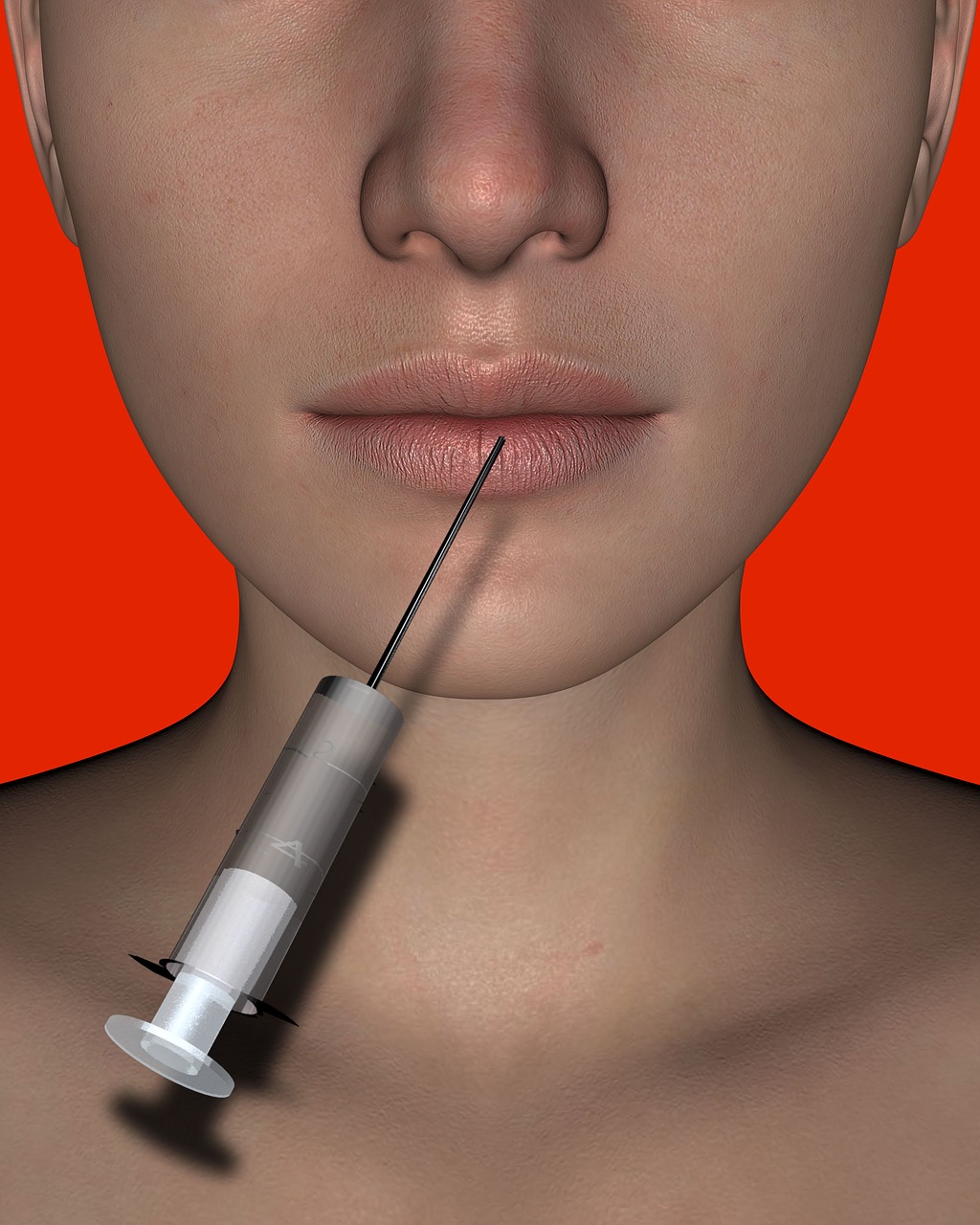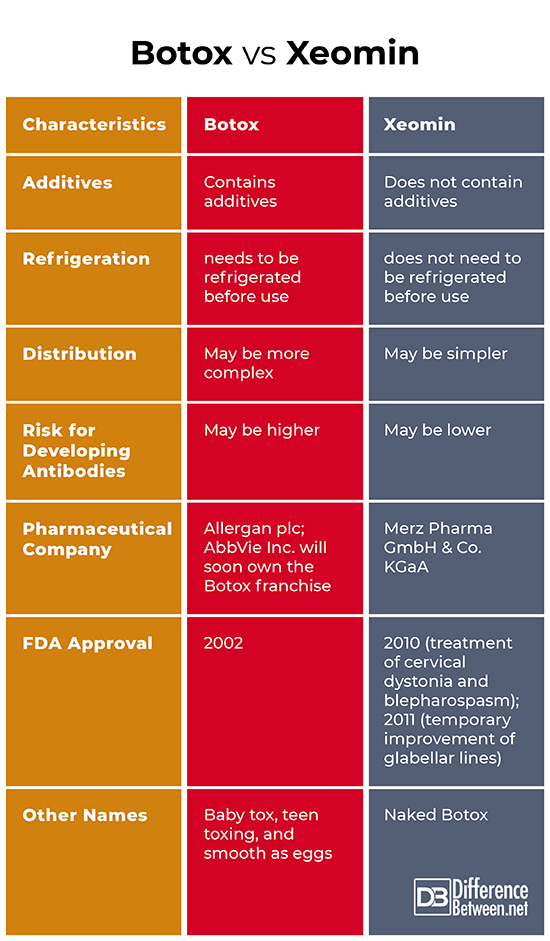Difference Between Botox and Xeomin
Both Botox and Xeomin are brand names of a neurotoxin which is being used to treat or lessen facial wrinkles and certain conditions like cervical dystonia, crossed eyes, and eyelid twitching. The other commercial versions include Dysport, Myobloc, and Jeuveau. They work by the same mechanism and their effects may last for three or more months. Regarding their differences, Botox contains an inactive protein while Xeomin is a purified form, that is why it is also referred to as “naked Botox”. The following discussions further delve into their distinctions.
What is Botox?
Botox is a brand name of a neurotoxin which disrupts the nerve signaling processes that are responsible for muscle contraction. The other names associated with Botox include “baby tox” (uses a lower volume of Botox), “teen toxing” (cosmetic procedures such as Botox injections among teens), and “smooth as eggs”. Botox injections can reduce wrinkles and help treat other conditions like excessive sweating, chronic migraines, lazy eye, eyelid spasms, crossed eyes, alopecia, psoriasis, and certain bladder disorders. (Nichols, 2020). Allergan plc is the maker of Botox; however, AbbVie Inc. will soon own the Botox franchise (Palmer, 2020).
The effect may last for three months or longer; hence, regular follow-up injections may be needed. A number of patients undergo two to six annual sessions. The risks of Botox injections include pain, swelling, flu-like symptoms, droopy eyelid, crooked smile, dryness of the eyes, or excessive tearing. However, when the procedure is performed by board-certified dermatologists, only less than one percent of the patients go through an issue. A Botox injection on a single area may cost from about $100 to $400 (Chesak, 2018).
Clostridium botulinum (C. botulinum), is the bacterium which produces the neurotoxin used in Botox injections. Only very small doses of the deadly toxin are used in medical treatments. Interestingly, this bacterium is commonly associated with botulism (a type of food poisoning) and misshapen or bulging cans due to the gas produced inside the sealed food container. Generally, C. botulinum is harmless, it is naturally found in forests, lakes, soil, and intestinal tracts. However, such bacteria begin producing botulinum toxin when they transform and when their population increases.

What is Xeomin?
Xeomin, a competitor of Botox, is manufactured by Merz Pharmaceuticals. It is used to treat cervical dystonia (painful and involuntary contraction of neck muscles), blepharospasm (abnormal contraction of eyelid muscles), and facial wrinkles. The United States is the 20th country to approve Xeomin. More than 84,000 people, from various nations, have been treated with this new drug. Since Xeomin does not need to be refrigerated before use, it may be more easily distributed. Moreover, since this product does not use additives, there may be less risk for patients to develop antibodies against Xeomin. When used to treat cervical dystonia, the side effects may include pain and muscle weakness. Regarding treating blepharospasm, the side effects may include dry eyes, sagging eyelids, dryness of the mouth, headache, diarrhea, upper respiratory infections, breath shortness, and visual impairment. Other risks may include allergic reactions and injection site bleeding and bruising (American Academy of Facial Esthetics, 2020).
Difference between Botox and Xeomin
Additives
The primary difference between Botox and Xeomin is the presence of additives. Since Xeomin has a more purified form, it does not have additives.
Refrigeration
Unlike Botox, Xeomin does not need to be refrigerated before use.
Distribution
As compared to Botox, the distribution of Xeomin may be simpler since it does not need to be refrigerated before use.
Risk for Developing Antibodies
Patients who use Xeomin may have less risk of developing antibodies against the neurotoxin as compared to their counterparts who use Botox. Since Xeomin has no additives, it may be less likely for the body to detect and attack foreign invaders.
Pharmaceutical Company
Allergan plc is the maker of Botox; the CEO is Brenton Saunders and the company’s headquarters is in Dublin. However, AbbVie Inc. will soon own the Botox franchise; its CEO is Richard Gonzales and the company’s headquarters is in Illinois. On the other hand, Merz Pharma GmbH & Co. KGaA is the maker of Xeomin; its CEO is Phillip Burchard and the company is based in Frankfurt.
Food and Drug Administration (FDA) Approval
The FDA approved the cosmetic use of Botox on April 15, 2002. In comparison, the FDA approved the use of Xeomin for the treatment of cervical dystonia and blepharospasm in 2010. After a year, its use for the temporary improvement of glabellar lines (vertical lines between the eyebrows) was approved.
Other Names/ Slang
The other names associated with Botox include “baby tox”, “teen toxing”, and “smooth as eggs”. In comparison, Xeomin is dubbed as the “naked Botox” since it is a purified form.
Botox vs Xeomin

Summary
- Botox and Xeomin are brand names of a neurotoxin.
- Xeomin, a competitor of Botox, is manufactured by Merz Pharmaceuticals.
- Unlike Botox, Xeomin has no additives, does not need refrigeration before use, may have a simpler distribution, and has less risk for the development of antibodies.
- The maker of Botox is Allergan plc (AbbVie Inc. will soon own the Botox franchise) while that of Xeomin is Merz Pharma GmbH & Co. KGaA.
- The FDA approved the cosmetic use of Botox in 2002 while that of Xeomin occurred 9 years later.
- Botox is also known as “Baby tox”, “teen toxing”, and “smooth as eggs” while Xeomin is dubbed as “naked Botox”.
- Difference Between Hematoma and Melanoma - February 9, 2023
- Difference Between Bruising and Necrosis - February 8, 2023
- Difference Between Brain Hematoma and Brain Hemorrhage - February 8, 2023
Search DifferenceBetween.net :
Leave a Response
References :
[0]American Academy of Facial Esthetics. Xeomin: What is it and How Xeomin Compares to Botox, 2020. https://www.facialesthetics.org/patient-info/facial-esthetics/wrinkle-treatment/xeomin/
[1]Chesak, Jennifer. The No BS Guide to Getting Natural-Looking Botox. Healthline, 2018. https://www.healthline.com/health/beauty-skin-care/guide-to-botox
[2]Palmer, Eric. Allergan Unveils New Botox Plant Ahead of $63B AbbVie Merger. Fierce Pharma, 2020. https://www.fiercepharma.com/manufacturing/allergan-unveils-new-botox-plant-63b-abbvie-merger-edges-to-completion
[3]Image credit: https://cdn.pixabay.com/photo/2017/03/06/18/29/lips-2122146_1280.jpg
[4]Image credit: https://i.vimeocdn.com/filter/overlay?src0=https%3A%2F%2Fi.vimeocdn.com%2Fvideo%2F435032851_1280x720.jpg&src1=https%3A%2F%2Ff.vimeocdn.com%2Fimages_v6%2Fshare%2Fplay_icon_overlay.png
